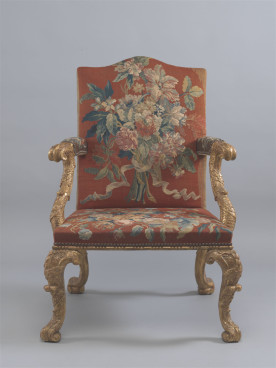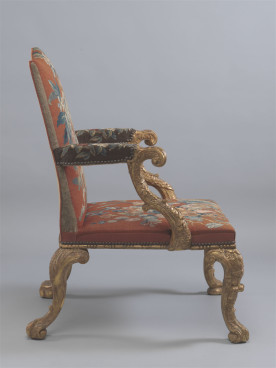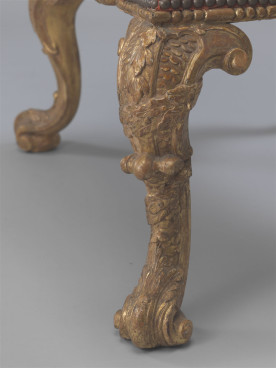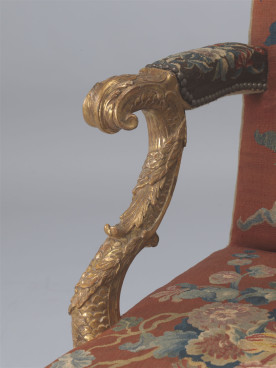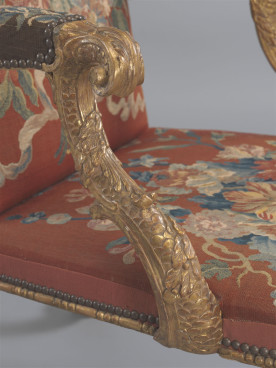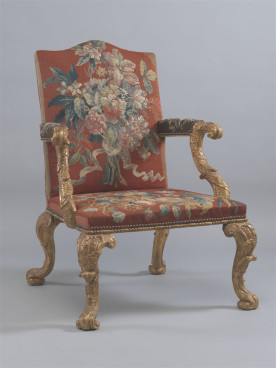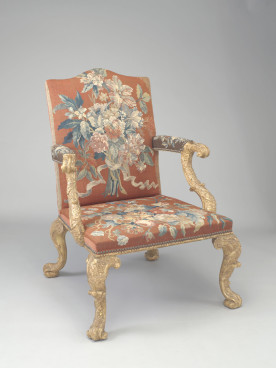Armchair, c.1745
Gilded walnut and beech with original tapestry upholstery
This chair is one from a set of six supplied by Wright and Elwick of Wakefield, West Yorkshire, to William Wentworth (1722–1791), 2nd Earl of strafford, of Wentworth Castle, Yorkshire.
Adam Bowett Catalogue (19/08/2012)
Description
A large upholstered, carved and gilded armchair, c.1735., The slightly arched rectangular back and trapezoid seat are covered with floral needlework on rust-coloured ground, while the arm pads have a brown ground. The arms have scrolling, leaf-carved terminals, the curved supports carved with fish scales and wrapped with laurel leaves. There is a bead-and-reel moulding around the base of the seat which is raised on cabriole legs carved with fish scales, scrolls and laurel leaf binding, to a leaf-carved, scrolled foot.
Dimensions
H: 40 ½ “ (103cm) Seat height: 17” (43cm) W: 29” (74cm) D: 31“ (79cm).
Materials
Beech, walnut (?), various upholstery materials.
Dating criteria
This is a chair conceived in the new ‘French’ or rococo style coming into vogue in the mid -1730s, although much of the detail (for example the fish scales) derive from earlier baroque designs.
Construction
Construction of the back is conjectural because fully enclosed by needlework. The arms are probably housed into the back uprights and secured with screws. The arms themselves are constructed in two parts, the upper horizontal elements being presumably mortised to receive a tenon from the lower part. The base of the arms is lapped over the side seat rail and probably screwed and plugged. The beech seat rails are tenoned all round into the legs which appear to be solid walnut. The scrolled brackets are tenoned into the top of the leg and glued up to the seat rail. The feet (and possibly other wide elements of the leg) are thicknessed on the outer two faces; they were originally hollowed to receive castors, the recess now filled with a wooden plug. There are beech struts across the two front corners and ash corner blocks screwed into the two back corners.
Condition
Condition of the back frame is conjectural, as is that of the arms where covered by fabric. It is thought that all the needlework is original to the chair, but more investigation will be necessary to confirm this. The arms, legs and the moulding around the base of the seat are water gilded. The gilding appears to be substantially original but there are obvious areas of retouching and some gold paint, for instance: at the joint between the upper and lower sections of the arms; around the edges of the upholstery of the arms; at the point where the arms are screwed and plugged into the set rails, and the bead and reel moulding around the seat has been particularly heavily retouched. There are similar areas of retouching to the legs, particularly around the feet. The front right foot has been re-made and re-carved to make good losses. Similar work to a greater or lesser extent on both back feet. The supporting blocks behind the front legs have at some time had a screwed reinforcement fitted, now removed. The shaped corner blocks to the rear rail are not original but the corner struts to the front probably are. There is some minor patching to the rear seat rail and all four rails are extensively pitted with tack holes (now filled) indicating that the chair seat was sprung at some time.
Provenance
2nd Earl of Strafford, Wentworth Castle, Yorkshire. By descent to Captain BC Vernon-Wentworth
Colonel H. M. Mulliner.
Purchased, Mallett July 1999.


